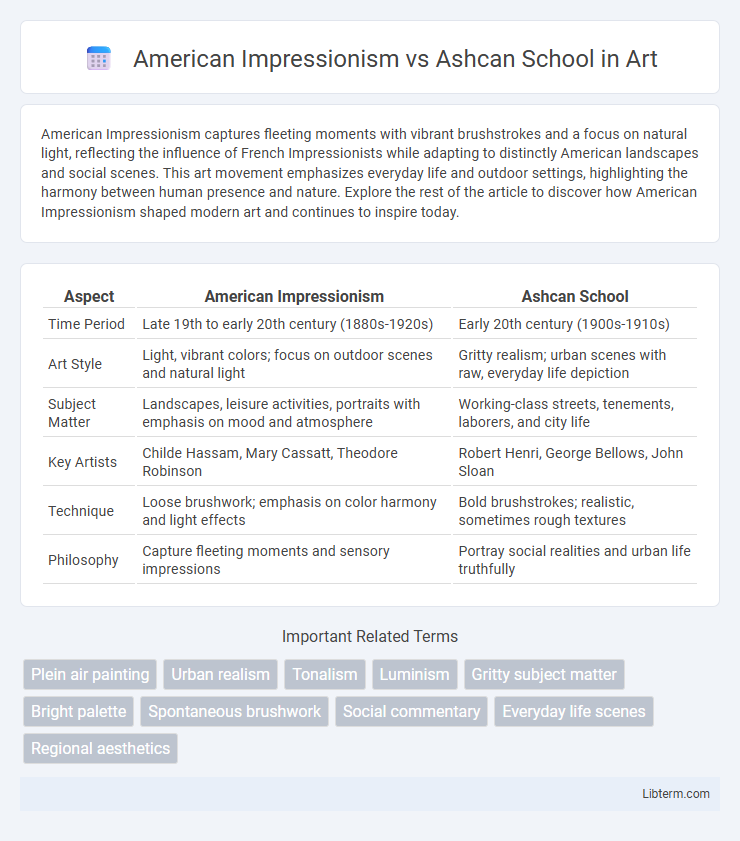American Impressionism captures fleeting moments with vibrant brushstrokes and a focus on natural light, reflecting the influence of French Impressionists while adapting to distinctly American landscapes and social scenes. This art movement emphasizes everyday life and outdoor settings, highlighting the harmony between human presence and nature. Explore the rest of the article to discover how American Impressionism shaped modern art and continues to inspire today.
Table of Comparison
| Aspect | American Impressionism | Ashcan School |
|---|---|---|
| Time Period | Late 19th to early 20th century (1880s-1920s) | Early 20th century (1900s-1910s) |
| Art Style | Light, vibrant colors; focus on outdoor scenes and natural light | Gritty realism; urban scenes with raw, everyday life depiction |
| Subject Matter | Landscapes, leisure activities, portraits with emphasis on mood and atmosphere | Working-class streets, tenements, laborers, and city life |
| Key Artists | Childe Hassam, Mary Cassatt, Theodore Robinson | Robert Henri, George Bellows, John Sloan |
| Technique | Loose brushwork; emphasis on color harmony and light effects | Bold brushstrokes; realistic, sometimes rough textures |
| Philosophy | Capture fleeting moments and sensory impressions | Portray social realities and urban life truthfully |
Origins and Historical Context
American Impressionism emerged in the late 19th century, heavily influenced by French Impressionism, reflecting a fascination with light, color, and outdoor scenes amid the Gilded Age's affluence. The Ashcan School arose in the early 20th century, rooted in urban realism and social commentary, depicting gritty, everyday life in New York City during rapid industrialization and immigration. Both movements responded to societal changes, yet American Impressionism idealized beauty and leisure while the Ashcan School confronted the harsh realities of modern city life.
Key Philosophies and Artistic Goals
American Impressionism emphasized capturing the effects of natural light and color to depict fleeting moments in everyday life, reflecting a refined, often idealized vision inspired by European Impressionism. The Ashcan School focused on gritty urban realism, portraying the raw and unvarnished experiences of city life with an emphasis on social commentary and dynamic brushwork. Both movements sought to challenge traditional academic art, yet American Impressionism pursued beauty and atmosphere, while the Ashcan School aimed to reveal the stark realities of early 20th-century America.
Notable Artists and Influencers
American Impressionism features notable artists like Childe Hassam, Mary Cassatt, and John Henry Twachtman, who emphasized light, color, and outdoor scenes influenced by French Impressionism. The Ashcan School includes figures such as Robert Henri, George Bellows, and Everett Shinn, known for their gritty portrayals of urban life and working-class subjects reflecting social realism. Both movements shaped early 20th-century American art, with American Impressionism focusing on beauty and leisure, while the Ashcan School highlighted everyday struggles in rapidly changing cities.
Subject Matter and Themes
American Impressionism emphasized light, color, and leisurely scenes of upper-middle-class life, often depicting landscapes, portraits, and domestic interiors with a soft, atmospheric quality. The Ashcan School focused on gritty, urban realism, portraying the everyday struggles of working-class New Yorkers, including street scenes, tenements, and social issues with raw, unfiltered energy. Subject matter in American Impressionism aligned with beauty and tranquility, whereas the Ashcan School highlighted social realities and stark human experiences.
Techniques and Brushwork
American Impressionism employs loose, vibrant brushwork with emphasis on capturing light and color variations, often using broken brushstrokes to create a luminous effect. In contrast, the Ashcan School features rougher, more vigorous brushstrokes that emphasize texture and raw urban scenes, employing a darker, earth-toned palette to convey realism and immediacy. Techniques in American Impressionism prioritize atmospheric effects, while the Ashcan School focuses on expressive, unpolished depictions of everyday city life.
Use of Color and Light
American Impressionism emphasizes vibrant, pastel colors and natural light to capture atmospheric effects, often depicting leisurely scenes with a luminous, soft focus. The Ashcan School employs a darker, muted palette with strong contrasts to reflect urban realism, using light to highlight gritty, everyday life and convey mood rather than mere optical effects. While American Impressionists prioritize light's transient qualities, Ashcan artists focus on narrative depth through shadow and tonal intensity.
Urban vs. Rural Imagery
American Impressionism primarily captures rural and suburban landscapes with soft brushwork and an emphasis on natural light, reflecting serene, pastoral scenes. In contrast, the Ashcan School focuses on gritty urban imagery, portraying crowded city streets and everyday life with a raw, realistic style. These differing approaches highlight the cultural and social contrasts between idyllic rural settings and dynamic urban environments in early 20th-century America.
Impact on American Art Scene
American Impressionism brought vibrant light and color techniques influenced by French Impressionism, transforming American landscape and portrait painting into a modern, accessible art form. The Ashcan School introduced gritty realism, depicting urban life and social issues with raw, unfiltered honesty, challenging traditional aesthetics and broadening subject matter. Together, they reshaped the American art scene by diversifying styles and narratives, fostering a more inclusive and dynamic cultural dialogue.
Legacy and Continued Influence
American Impressionism, characterized by its vibrant light and color, laid the groundwork for modern American art by influencing artists who embraced plein air techniques and a focus on everyday beauty. The Ashcan School, with its gritty urban realism, left a legacy of social awareness and candid depictions of city life that inspired later movements like Social Realism and American Scene Painting. Both movements continue to shape contemporary art by encouraging diverse approaches to representing American experiences and environments.
Comparative Analysis and Lasting Significance
American Impressionism emphasizes light and color with loose brushwork reflecting tranquility and leisure scenes, while the Ashcan School adopts gritty realism, portraying urban life and social issues with darker palettes and dynamic compositions. Both movements significantly shaped early 20th-century American art, influencing modern artistic perspectives on everyday experience and social commentary. The lasting significance of American Impressionism lies in its contribution to modern color theory and plein air technique, whereas the Ashcan School's legacy endures through its unvarnished portrayal of urban realism and social consciousness.
American Impressionism Infographic

 libterm.com
libterm.com